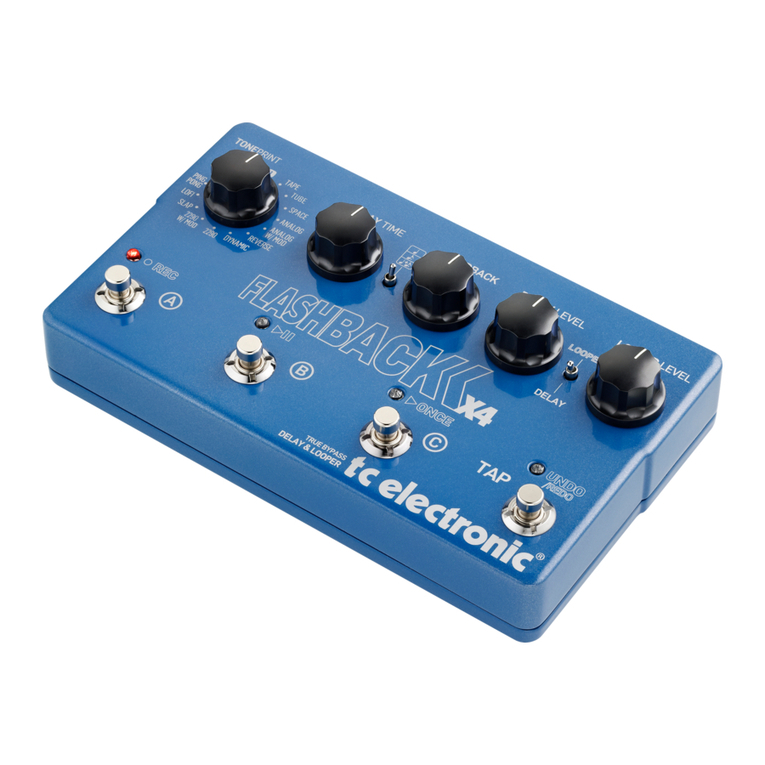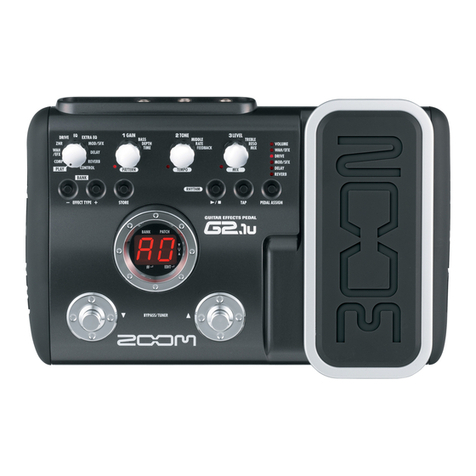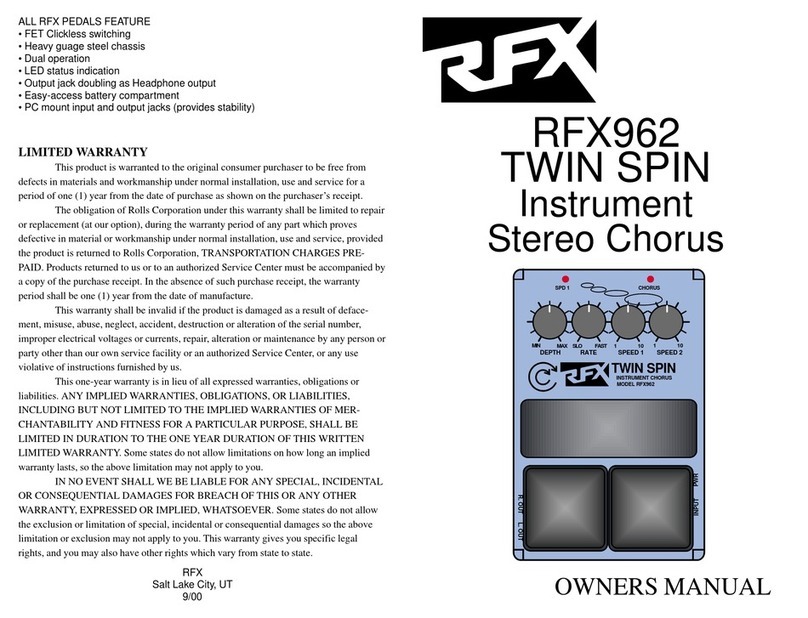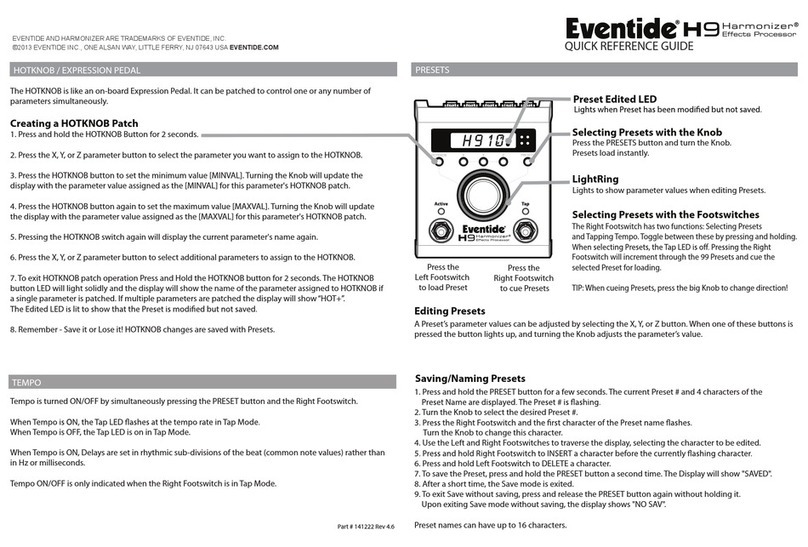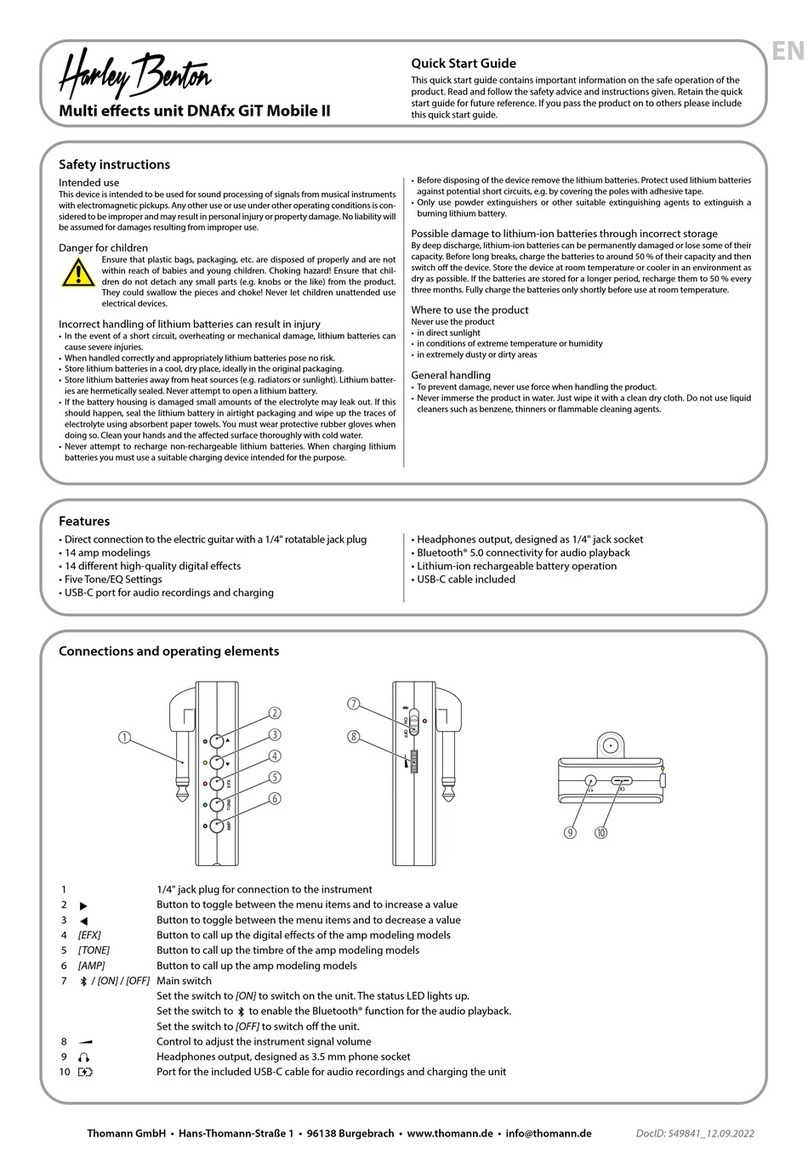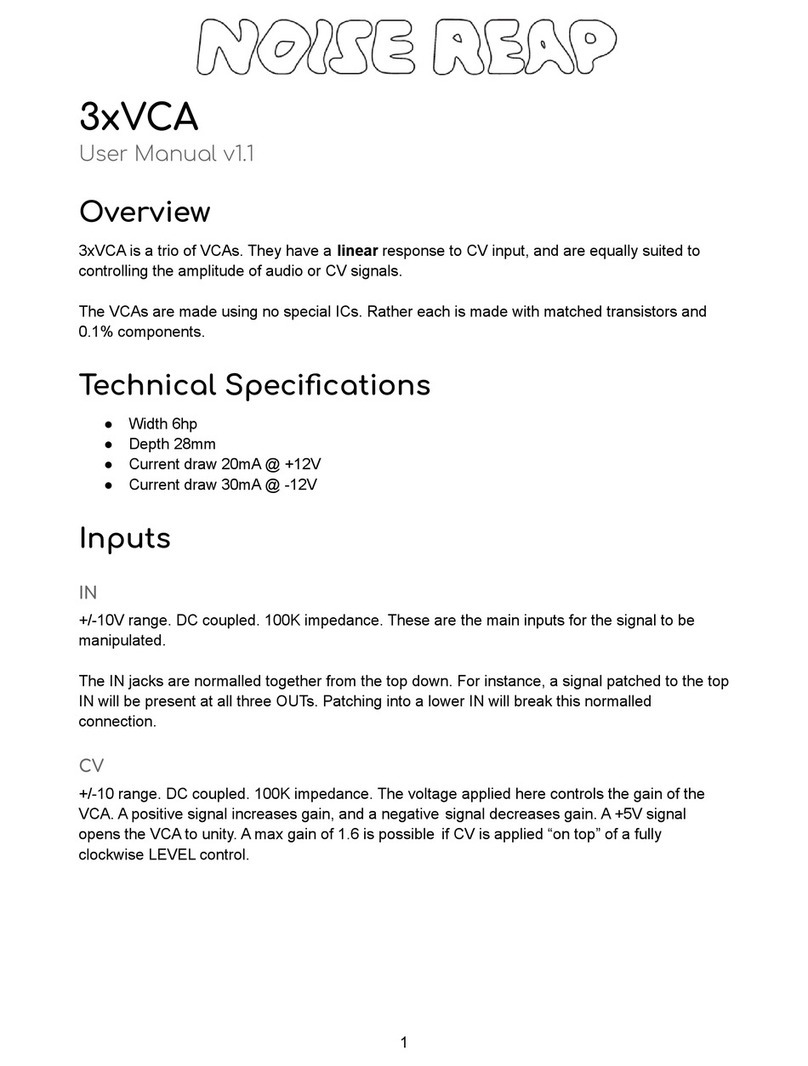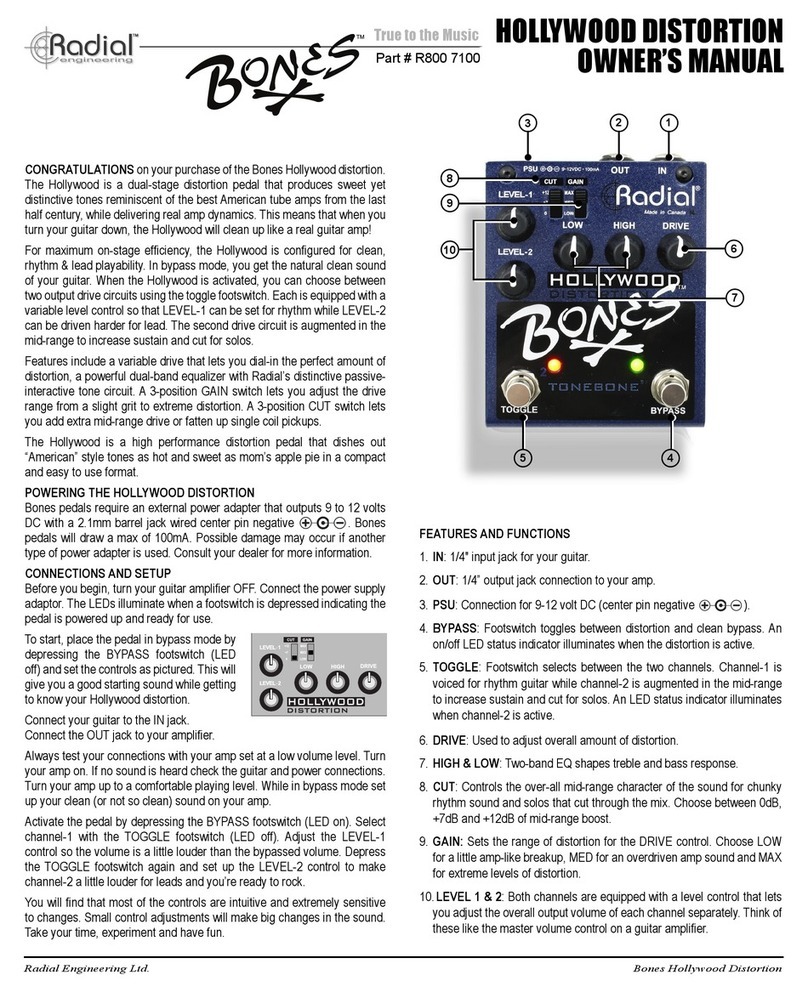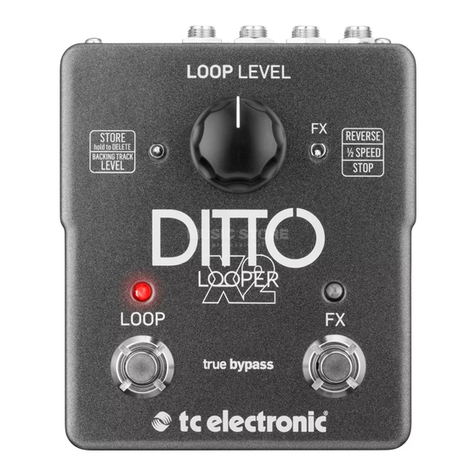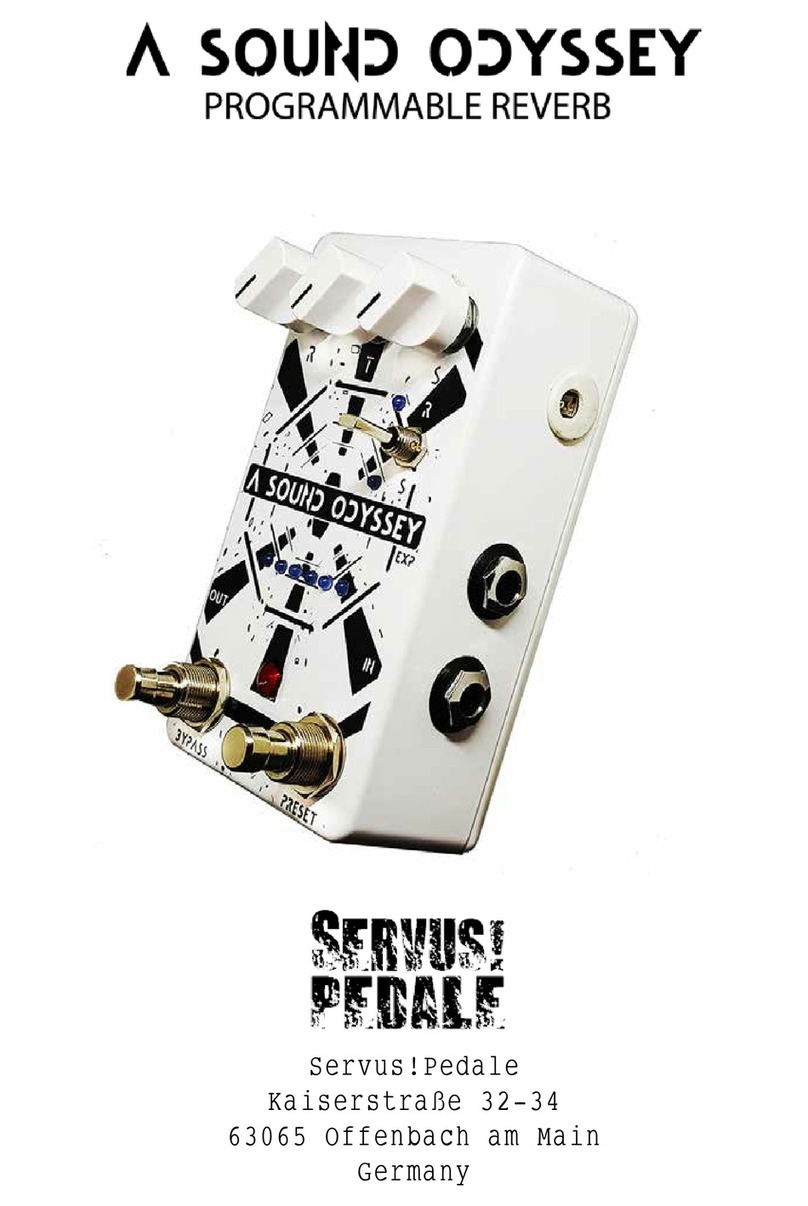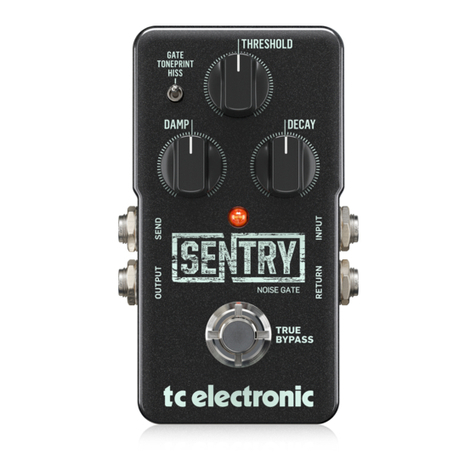Snazzy FX Kitty Eyes User manual

Kitty Eyes
Snazzy FX loves chaos, and we want you to have a piece of it too! Not
necessarily chaos in the sense of everything going crazy, but chaos as
found in natural systems: dripping faucets, kinetic interactions or fractals
The Kitty eyes has most of the features of our bigger chaos modules but
with a lower price and footprint
Features
•Two chaotic outputs with different characteristics
•Trigger output
•Threshold control for setting chaotic trigger density
•CV attenuator for CV input
•Speed control for setting the coarse pitch set of the chaotic system
•Bi-color LED to indicate the state of the chaotic oscillator
Uses
•Works great as a modulation source for any module requiring 2
CV inputs (i e the Snazzy FX Ardcore)
•Use it with a VCA to create unique percussion sounds
•Chaotic triggers add an organic element to sequences or to drum
patterns
•Works well for modulating VCOs and filters
•Works well as a unique “noise” source
•Feed audio signals into the CV input for interesting effects
•Use the chaotic trigger output as a strange audio out
•CV input resets the chaotic oscillator when fed with a trigger,
sawtooths and pulses – can be used to disturb the chaos
•Perfect for experimenting
Width 6HP
Current draw 10mA

Front panel
I speed control of the chaotic system
II bi-color LED chaos indicator
III CV attenuator
IV threshold control
V trigger LED
VI X chaos output
VII Y chaos output
VIII CV/trigger/audio input
IX trigger output
II Shows the movement of the chaotic oscillator
V Shows the operation of the threshold control Use it to set your
TRIG output
VI Can be used an audio source, as a substitute for noise when
building percussion sounds, or as a CV style output to drive
sample & holds, the Telephone Game, wogglebugs, or any
module which is looking for changes in a signal (Ardcore and
Telephone Game both work extremely well with these outs)
VII Similar to VI, but with a different phase, and a different tonality
Check the sound of both outs when creating drum sounds This is
the output which drives the chaotic triggers The X/Y outputs are
what you connect to the oscilloscope in X/Y mode to see the
attractor
I II
III
VI
V
IV
VII
VIII IX

Controls and operation
SPEED
Moving clockwise, this knob increases the frequency of the chaotic
oscillator It is labeled speed as opposed to pitch, since the “pitch” of the
chaos is not a single frequency or tone as in a VCO Rather, you can
control the speed of the whole system: as you turn the knob clockwise,
frequency increases until the system dies out at max rotation This control
is very interactive with all the other controls
*Tip* When using Kitty eyes in the chaotic trigger mode, chaotic triggers
are easiest to dial in toward the near-end of the dial, as the signal is most
chaotic in this area (75% to 95%)
CV
This knob has an effect on the module's behavior with or without CV
plugged in, as the pot connects to a fixed voltage when nothing is
connected You can use it as a fine tune knob for the chaotic oscillator
when no CV is plugged in However, as soon as you start plugging stuff
into the CV jack, it behaves as an attenuator
The CV input is interesting, as you can really stick just about anything
into it, with varying results Triggers work very well for locking the Kitty
eyes to beats or rhythmic material, especially when creating chaotic gates
which are loosely related to a grid When putting triggers into the Kitty
eyes, simply choose a pattern (say four to the floor triggers), then adjust
the CV knob so that the attractor is “pushed” every time it gets a trigger
The trick is to set it so that it generates a usable result Then set the
threshold control to taste Once again, best results are generated near the
end of the speed pot
Other uses of the CV depth knob and input can include inputting sharp
waves like PWM squares, sawtooths, and clipped sines or triangles
Results will vary with regular smooth waves like sines or triangles
One other area that is interesting to explore is inputting audio into the CV
jack Depending on the level of the signal and its content, you can get
some interesting sounds! At times the Kitty eyes can sound like a synced
VCO on its last legs, and you might even be able to get it locked to your
favorite pop song if you smash it through the HI_GAIN first!
As with other Snazzy FX chaos modules, experimentation is key And the
controls are all highly interactive Inputting audio signals can have
interesting results in chaotic triggers You can also try inputting chaos
from another module or white noise!

THRSH
This knob controls the output of the TRIG output jack Depending on the
setting of SPEED and CV, the knob can either be used to create chaotic
triggers or a sharp, needle pulse audio wave To use the TRIG output as an
audio output, simply set the Threshold so that the trigger LED stays
constant, and take your audio from the TRIG output You can also play
around with feeding the TRIG output back into the CV input Sometimes
this creates usable results
If you are going for chaotic triggers, set the Kitty eyes to max chaos with
or without an incoming CV, then adjust the CV knob for fine tuning Then
set the Threshold knob to taste It may take some getting used to how to
best set up chaotic triggers, but it is worth the effort as they really do have
a life of their own
One interesting way to approach it is to simply run your trigger sequences
straight into the Kitty eyes' CV input If you then set the SPEED and
THRSH properly, you should be able to use the module to “process”
trigger patterns Ultimately, you will be using a mixture of chaos and
triggers to create a signal that has useful rhythmic properties The Kitty
eyes will lean towards very fast streams of pulses, so you can use your
triggers to “force” it to stop or slow down Then use the threshold control
to pull it back so the triggers are not happening as often
Chaotic Triggers
•Are one of the most musical uses of chaos
•Use them to reset your sequencer
•Use them to pulse shift registers
•Use them to control the rotation of clock dividers or to clock other
modules
•If you set up complex patches utilizing feedback, you can have
the Kitty eyes both responding to a sequence and determining the
reset of that same sequence
Another interesting use of chaotic triggers is controlling the accent of
drum modules For example, take a simple trigger pattern from a trigger
sequencer Plug this into a hi-hat module Now take another trigger
sequence from the same trigger module, and patch it into the CV input Set
threshold to taste Now take the TRIG out signal and plug it into the
accent input on the hi-hat module Adjust the depth You should now have
a hi-hat pattern that changes in volume in a chaotic way This could also
be applied to other inputs on drum modules
One more useful thing to do with chaotic triggers is feed them to a
clock or octave divider If you slow them down, you end up with
interesting patterns which can be used to clock modules or open VCAs
Of course, many Snazzy FX modules are custom made to work with
chaos! The Telephone Game works extremely well with the X/Y outs from
the Kitty eyes as does the Ardcore (which has many patches which look
for two CVs to determine the operation of the program) The HI_GAIN
works well when using the Kitty eyes as a module in the feedback loop
And the Telephone Game’s “loop” trigger is operated extremely well by
the chaotic triggers
Other manuals for Kitty Eyes
1
Table of contents
Other Snazzy FX Music Pedal manuals

